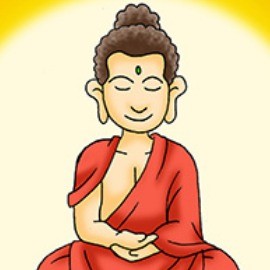THE RIGHT EFFORT

The first three noble paths deal exclusively with the accumulation of spiritual understanding and the moral restraint that this knowledge engenders. There is nothing in the first five paths that differs radically in approach from the moral teachings of western theologically based religion. The main difference in approach is found in the total emphasis of Buddhism on the process of self transformation as being self generated rather than other generated. Other than this, there is that little separates Buddhist moral teaching from any ethically based system of thought, religious or otherwise.
The radical departure from other religious traditions begins with the sixth noble path, the path of right effort. Right effort, Sama Vayama in Pali, could also be called perfect or right concentration, in as much as it signifies effort with a specific direction. Direction is the first step in turning energy into effort. To have direction, of course, it is necessary to have the groundwork of understanding that comes with following the preceding spiritual paths.
Once again, the indivisible nature of the interdependence of these paths reveals itself. A careful analysis of this spiritual process reveals time and time again that it is an organic system, consisting of respective paths whose mutual integrity is so interconnected as to make it impossible to violate one path, without disrupting the entire process. This is why Buddhist traditions, which have relied too heavily on one aspect of the path to the detriment of the others, produce unbalanced results. Those Zen sects that ignore the importance of strict adherence to moral behavior of the first five paths, while vigorously pursuing the enlightenment experience can produce dubious Zen masters. These masters may have powerful meditation ability, and powers of personality that border on the occult, but are not enlightened in any real Buddhist sense. For real enlightenment can not be divorced from the enlightened way of life, which is the eight fold path.
There are many Buddhist moralists who eschew the practice of meditation as too spiritually difficult. These people rely solely on faith in the Buddha or a magical formula to save them. Such people teach that this age is too dark to produce enlightened beings, so why bother.
Buddhists who hold such notions have forgotten that Buddha taught the middle way as embodied in the eight fold path, and no individual or tradition has been able to surpass this doctrine in sublimity or effectiveness. The Buddha did make allowances for the various temperament of each individual by teaching many ways to approach the path utilizing one's inherent strengths. He never, however, advocated abandoning any of the paths as too difficult or irrelevant. It is important, therefore, that we never lose sight of the essential necessity of perfecting ourselves in each path, even as we focus our attention on a particular path as the center of our practice.
In the same respect, it is equally important that we respect all the various traditions of Buddha dharma and non-Buddhist dharma, not denigrating any of them since they all represent different approaches to the eight fold path according to the spiritual disposition and understanding of the practitioners.
It should be mentioned that there are a couple of quasi Buddhist organizations which pay no heed to the eight fold path at all, simply advocating the chanting of a particular magic formulae for attaining whatever one wishes, as if this was the goal of Buddhism. This sort of spiritual degeneracy exists in all religious traditions at one time or the other, and is easily separated from real spiritual traditions by the superficiality of its doctrine and adherents.
In order to muster the energy necessary to complete the sixth noble path, one must have faith that by their own exertions they can reach the goal. Faith is an element of practice that is not stressed in Buddhism because our practice itself is systematic and if properly done, self supporting. This does not mean, however, that the concept of faith is not relevant to our practice. In fact it is of extreme importance if we are going to have the resiliency necessary to deal with the challenges of the spiritual life.
Although we know that the Buddha and his disciples have attained the way through following the same path as ourselves, we still have no direct experience of the power of their enlightenment before we ourselves are enlightened. The best we can hope for is to find venerable teachers who embody the tradition in their person to such a degree that we are inspired to follow them. There is a problem with this type of faith, however.
First of all, to be a human being is to have karma. This means that everyone is subject to the forces of cause and effect. It is only when one reaches the exalted state of Buddha or advanced Bodhisattva that one can be said to be perfect in the moral sense. Unfortunately, there are very few of these people around to guide us. In their absence, we will have to settle for more mundane examples of Zen Masters, Lamas and the like. A few of these are advanced Bodhisattva, but certainly not all. Even advanced spiritual practitioners are capable of moral error, and thus capable of potentially leading weaker students astray through their actions. There is a good deal of difference between our common garden variety of Buddhist master and a living Buddha. I think it behooves us to examine the difference, with the Zen Master as an example.
What is a Zen Master? This is a term that is used quite loosely in the west. I have often heard any number of advanced Zen practitioners in America referred to as a Zen Master. When the title is used in Japan it signifies a priest who has been given the title Roshi or Zenji. Roshi literally means revered or older priest and is usually only given to senior Zen priests past the age of fifty who are considered to be worthy in the Soto tradition. The term Zenji is used interchangeably with Roshi in Rinzai, while it is only used in Soto by those who receive the title from the Emperor. In the Rinzai tradition, the title Roshi is given to any priest who has been given Inka Shomei. Inka is the seal of transmission certifying that a legitimate Zen Master recognizes the priest as enlightened and worthy of teaching at that level. In Rinzai, this comes when the student has passed through all the various levels of Koans and the teacher feels that he is ready to assume the responsibility inherent in the title. In Soto, the process of certifying transmission of the Zen lineage is done through shiho, a continuous face to face merging of Master and disciple. This is unique to Soto, but parallels the Roshi Koan interchange found in the Rinzai dokusan process.
Dokusan and sanzen are private interviews with the Roshi where the student tests his Zen understanding through Koan work or simply discusses his practice with his teacher. In Korean Zen a priest must receive certification from five Zen Masters before his master will give him transmission. In Korea, a Zen Master title is Sa Nim and a regular monk Su Nim. In China and Vietnam, the process for transmission is no longer consistent because of the disruptions of the lineage due to the Communist takeovers.
In order to understand what a Zen master is, one has to understand the principle of enlightenment. A Zen Master is considered to be Enlightened, which means that he or she has experienced Satori, the direct experience of ones true nature. To be enlightened is not the same as being enlightenment, which means that one abides in the state of enlightenment. If one abides in the state of enlightenment, then one is a Buddha. A Buddha is one who is the manifestation of Bodhi or enlightenment.
To be a Buddha is to have a Karma which is supra mundane, and this is why in Buddhist mythology, a Buddha is said to have the 32 marks of the superman.
Thirty-two refers to the eight fold path multiplied by the four noble truths. In other words, these signs are a symbol for the perfection of the truths of existence in the life of an individual. The Buddha possessing these marks represents the merging of the universal (four noble truths) with its manifestation as his life (the eight fold path). A Buddha is one who no longer creates Karma because the individual will, which is the creator, is no longer present. There is only the continuing reality of the Buddha Mind, which being infinite, cannot have a finite form. Since Karma is the manifestation of individual energy, a Buddha no longer creates it. A Buddha is called Tathagata or one who is suchness in reference to the merging of his personhood with the manifestation of existence.
Suchness is the eternal quality of the present reality as it is. As we say in Zen, "The flowers are red, the leaves are green". A Zen Master is one who has seen red flowers and green leaves as not separate from himself. One who is red flowers and green leaves. A Zen Master is, however, not a supra mundane being who has put an end to his karma. Since he still has karma, he is still subject to delusion to some degree or another. Therefore, he is capable of making moral error. A Zen Master should be a morally superior person even if he or she is not perfect. The title should reflect not only experience of wisdom, but knowledge of moral law and compassion for other beings. This precludes the possibility of this person making consistent moral errors from which they refuse to repent.
Unfortunately the experience of enlightenment in its weaker manifestations does not coerce people into moral behavior. It can, in some cases, have just the opposite affect. It can give a person a sense of oneness that makes moral considerations seem to be as important as straw in the wind. Real enlightenment transcends oneness and all other mental considerations. One behaves morally because moral behavior is the perfect expression of our compassion for the world. There is no longer the arbitrary boundaries of self and other, even on a subtle level.
Zen Masters and other Buddhist masters being capable of error, presents a problem for those who look to them as perfect and as the source of faith in their practice. Faith must be grounded in a firm conviction in the reality of the eight fold path as a vehicle for self transformation, and this faith must be complemented by a realistic attitude toward the karma of individuals. One of the best warnings delivered to dharma students of the danger of misplaced faith was given by Tibet's great sage, Milarepa, who wrote a series of warning to his disciples, entitled the Ten False Resemblances. They are as pertinent today as they were in his time.
- Desire may be mistaken for faith.
- Attachment may be mistaken for benevolence and compassion.
- Cessation of thought process may be mistaken for the tranquil enlightened mind.
- Sense perception and psychic vision may be mistaken for Reality.
- A mere glimpse of Reality my be mistaken for complete realization.
- Those who outwardly profess, but do not practice religion may be mistaken for true devotees.
- Slaves of passion may be mistaken for masters of yoga who have liberated themselves from conventional laws.
- Self interest may pass for altruism.
- Deceptive methods may be mistakenly regarded as being prudent.
- Charlatans may be mistaken for Sages.
As we can see by Milarepa's warnings to his students, faith in teachers as a faith in tradition itself is only justified when one has the necessary common sense to delineate between sages, ordinary men, and charlatans. Faith in teachers should be based primarily on an understanding of a teacher's credentials and their sincerity. To believe that one person represents an entire spiritual tradition is deluded. All traditions contain within them a wide variety of individuals each with different levels of training, intelligence, and spiritual sensitivity. If this were not the case, there would be a very limited and stereotyped level of instruction available. It is the student's job to seek out the teacher and tradition which is most efficacious for his or her spiritual development.
At the point where one chooses their spiritual path, they must make a commitment to following it with their whole heart. This does not require a suspension of the faculty of reason or moral judgment, but an application of those qualities to their practice. Any teacher who would request a person to commit to any action that is inherently destructive or immoral is violating that person's spiritual trust. The student teacher relationship is a sacred trust which requires a total commitment on the part of both parties. The most important commitment is to the practice itself. This is the real practice, not adoration of the teacher, but commitment to putting the teachers instruction into practice.
The beginning of the practice of right effort is in controlling ones mind to avoid destructive or unwholesome states of consciousness. Just as it is with the physical body, the mental body, consciousness, is best kept healthy through preventive medicine. It is a great deal more difficult to rid oneself of deleterious mental conditions than it is to prevent them from arising in the first place.
The Buddha delineated five mental conditions which were hindrances to right effort. These are sensual desire or craving, ill will, dullness and drowsiness, and restlessness and worry. The first hindrance, craving for material things and sensual desire is the strongest of the hindrances. Attachment to sensual pleasure, position and fame are the most common forms of this complex of desires. This can easily be seen in the predominance of these elements as a lure in advertising. Advertisers have to know what elements of the modern psyche are motivational to be able to market effectively.
In a society in which reason holds an exalted position, people who market goods and services advertise effectively by lucid exposition of their products merits. In this society people market effectively by appealing to sexual appetite, social insecurity and a desire for personal recognition. Therefore, we have automobiles described as sexy, and movie stars and athletes of dubious intellect hawking everything from snacks to socks. Even though it is irrational to equate an automobile with sex, or buy a pair of socks because an actor promotes them, nevertheless, people do act upon such motivations.
What happens when we allow desire to run our lives, is that we are thrown into a perpetual state of confusion. Confusion exists because our mind tells us that when we attain a particular thing, we will be fulfilled. When we do attain it, the satisfaction received is not commensurate with the energy expended in obtaining it. We are then motivated to look for something else to fill the gap in satisfaction and so on, until we become addicted to pursuit and desire to the extent we hardly ever know a moments calm. This, unfortunately, is the way most people live their lives, devoid of insight and peace and driven from one situation to the next, totally at the mercy of their temporal fortunes for their sense of well being.
To a person grounded in the eight fold path, this pitiable state is not possible. One understands that well being is contingent upon a mind that is free of attachment to things and situations, since these are all, by nature, ephemeral and transitory. Reality and pleasure are to be found in the beauty of the moment and its possibility for intelligent and compassionate action. There is no need to pursue an endless chain of things looking for a mythical pot of gold at the rainbows end. A rainbow is a thing of consummate beauty; why search for anything else? Ill will is another crippling attitude that is predominate in society, and our attachment to it is also used by the media to sell their products.
Hatred, resentment, anger, Dirty Harry, Rambo, Death Wish, all born of the same ignorant attitude toward the world. Our streets are full of hostile alienated people. Our roads have become shooting galleries and the media asks, "Why?". Why not, when every hour on the hour our children can be exposed to countless murders, shootings, revenges, beatings, rapes and other forms of television entertainment.
To a person on the path, there is a recognition that since all faces are ones own, it is not possible to take pleasure in revenge or indulge in fits of anger based on the deluded notion of absolute self and absolute other. We recognize all hatred is self hatred, and self hatred is the result of a personality that is not integrated. Therefore, when we experience hatred, we look to ourselves for self correction and not to revenge. We likewise find no entertainment in literature or films that promote vengeance as appropriate. Justice is sometimes swift and deadly, but when it is true justice, the emotional shadow of hate is completely absent. The only appropriate emotion for applying extreme sanctions is sorrow.
Unfortunately, the mind is a clever beast and quite capable of switching tracks from hatred of men to hatred of situations or things. It does this because it has become habituated to certain emotions and when it is deprived of them and the psycho somatic state they represent, it feels ill at ease. The mind and the body are not separate realities for the Buddhist, but manifestations of each other, as is energy and matter. They are correlates of a constituent reality. Mind manifests the body through karma, and the body manifests the mind in its actions. We can not witness the mind outside the movements of the body, and we can not perceive the body outside the mind.
To use the analogy of energy and matter, we can say that all matter is composed of patterns of energy and energy always expresses itself in patterns that are material or material effecting. If this were not the case, we would be unable to recognize energy at all because we would have no reference for it.
It is the same with mind and body. Each effects the other and produces the other interdependently. When one becomes habituated to a particular emotional state such as anger, there exists a matrix of mind and body; the mind effecting the body by eliciting chemicals appropriate to the emotions, like hormone excretions. The body becomes used to these hormone and chemical levels and when deprived of them becomes hypersensitive to any mental reaction which might parallel the original emotion, and thus release the same chemicals. An example of this can be found whenever we have an emotion which is inappropriate to a situation either because of the intensity of the emotion or by the nature of the emotion itself.
For many years I had a friend who had been a badly abused child which resulted in a major problem with feelings of anger and betrayal. This person was a dharma student, and over the years had come to understand that hate toward other persons was inappropriate. However, for years this person had become habituated to anger and the psychosomatic condition of a person in that state. Whenever an occasion arose that did not accord with my friend's aesthetic viewpoint or personal convenience, my friend would go into a blind rage. This rage was not directed at anyone in particular, but the world or life itself. This is not an uncommon occurrence with many people who find political, religious or artistic differences infuriating and depressing.
As disturbing as pollution, corruption, injustice and ignorance is, it is still not an appropriate vehicle for anger on the part of dharma students. Compassion and enthusiasm for work toward remedying these conditions should take the place of anger, resentment and repulsion. Those emotions do absolutely nothing to remedy incorrect situations, they only enhance the probability of them becoming worse.
Negative mental conditions arise because we have allowed our senses to carry us along without direction. It is like being in a canoe with paddles, but not using them, allowing ourselves to drift with the current. Meditation and mindfulness are our oars, allowing us to navigate, using the river of experience to propel us instead of hinder us. We can not get out of the river by shutting off our senses. We must learn to use them and not let them use us. One does this by concentrating on the sense itself, and shutting off the conceptual echo that follows it. When we see a beautiful object, we enjoy being in its presence, but when we, the walls of ego, echo back, "I want this", we ignore the sound and concentrate on just being in the moment. Our practice of meditation and mindfulness of the seventh and eight paths allows us to quiet our minds and penetrate the beauty of the moment.
Little by little, the ego, which is nothing more than layers upon layers of opinion, begins to disappear like a slowly peeled onion. There is no self left to want anything and yet there is a whole universe to be enjoyed in the moment. This enlightened state will never occur unless we are properly disciplined in restraining the ego dominated mind from linking up with the senses to carry us out of the moment and into a vortex of craving.
The next challenge of the path is to overcome mental sloth in the form of a dull and sleepy mind. There is no possibility of making any mental gains either intellectual or spiritual, if the mind is languishing in torpor. The practice of spiritual concentration requires an alert and motivated mind. Many meditation students complain to me that they have trouble staying alert when they are relaxed. This is the result of an addiction to excitement in daily life that exhausts the mind and body. When the body and mind have a chance for a rest from this constant turmoil, they naturally go in to sleep mode and fall into unconsciousness.
This problem can not be solved merely by applying one meditation technique or another. It can only be remedied by changing the way one relates to their life, so that the mind becomes used to tranquillity and equanimity in the midst of activity. Then when confronted with an opportunity for meditation it will simply come to rest naturally. Meditation must come as a natural part of ones life and be consistent with it. If someone lives a life based on excitement and attachment to the world, then meditation will have no permanent effect on the quality of their life. This would be like going to Alcoholics Anonymous meetings in the morning and the cocktail lounge in the evening.
Mental attitudes as just described are about half the reason students suffer from a dull drowsy mind. The other half is usually due to poor health habits, such as minor eating disorders, lack of exercise, or simply not enough sleep. The mind and body are in constant communication and we make it very difficult for ourselves when we do not take reasonable care of our bodies. The Buddha taught the middle way and this certainly applies to attitudes toward health. We should do our best to eat reasonable, exercise, and be mindful of our body.
On the other hand, fanaticism about health is also to be avoided.
The body is impermanent and no amount of exercise or dieting will keep it alive forever. To spend hours each day exercising and haranguing friends about their health habits is definitely not the sign of an enlightened mind. Surprisingly, quite a few of my students have felt that this behavior is somehow appropriate. I put this down to the result of conditioning in this society which continually markets the idea of eternal youth. I do not encourage them in this delusion, however, for if they spend half the energy in spiritual training they expend on their bodies, they would all be sages.
The final group of hindrances is composed of restlessness and worry. This is one of the easiest of the negative mental sets to control. It requires a firm belief in the efficacy of the teaching and an understanding of spiritual reality found in the first noble path. If one firmly believes in the spiritual laws of cause and effect and dedicates themselves to acting accordingly, a miraculous transformation begins to take place in the psyche. Restlessness which is caused by a combination of fear and addiction to stimulation, sensual or conceptual, is cut off from its roots when the mind becomes grounded in a spiritual world view. To understand that ones very being is no different than the Buddha Mind itself is to realize freedom from fear. We simply have to act in a manner consistent with compassion. The result will be compassion directed back into our lives.
In the final analysis, the effort we exert in our practice is efficacious to the degree we have mastered the lesson of the proceeding paths. Students of dharma who find themselves incapable of sustained effort in practice are invariably lacking in diligence in adhering to the first four noble paths. We have become so accustomed in the west to separating functions for the purpose of analysis, that we fail to see the importance of the intrinsic dynamic of interrelationship, which constitutes reality. While all aspects of reality are relative, reality itself is absolute. When this understanding is lost, we lose ourselves in perspective, which is a kind of spiritual sleep.
We become capable of rationalizing away destructive actions because we isolate the effects of those actions to what our perspective illuminates at the moment. The spiritual consequence of this is similar to the effect of using indiscriminate pesticides in farming. To achieve the effect of killing pests, you also pollute the farm, which in the long run is more damaging than the threat of the pests.
To concentrate so much on faith, meditation, or morality, to the point where the whole of spiritual life is eclipsed by singular spiritual obsession is absurd. The perfection of spiritual effort is found in a balanced approach to life that sees each part of the spiritual path is integral. In order to fully energize this spiritual integrity it is necessary to be cognizant of what is required of us in the moment. Without this awareness we have no direction for our effort, and this is why our next path of action is the path of right mindfulness.



























